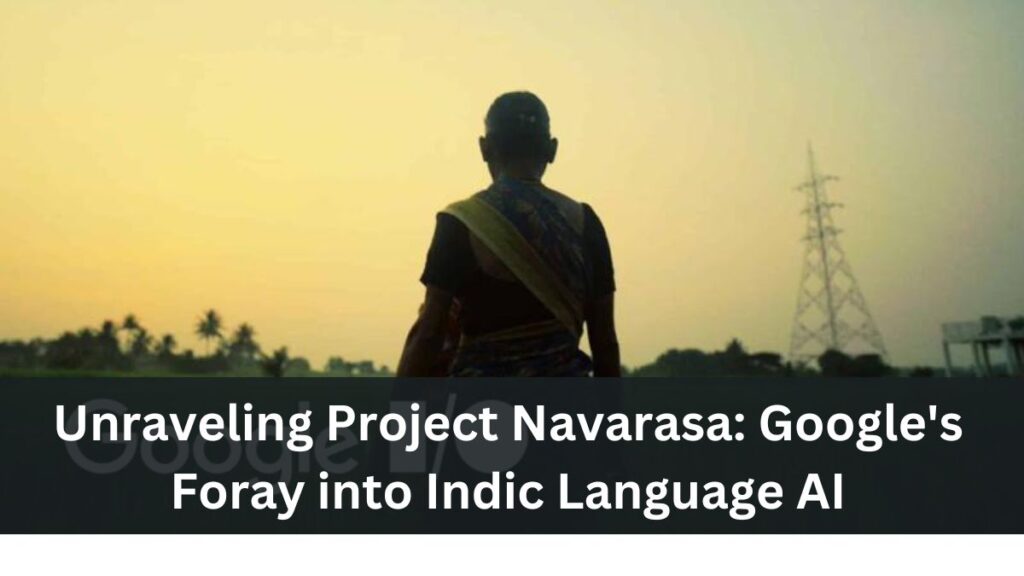Introduction: Google’s Pursuit of Linguistic Diversity
In a world where language is both a bridge and a barrier, technology has the power to transcend linguistic boundaries. Google’s latest endeavor, Project Navarasa, showcased at the prestigious Google I/O event, exemplifies the tech giant’s commitment to linguistic inclusivity and cultural resonance. This article delves into the intricacies of Project Navarasa and its implications for the landscape of artificial intelligence (AI) in the realm of Indic languages.
Project Navarasa: A Multilingual Marvel
At the heart of Google’s ambitious venture lies Project Navarasa, a groundbreaking initiative aimed at harnessing the potential of Gemma, an open vision-language model, for Indic languages. Developed by Telugu LLM Labs, Project Navarasa represents a collaborative effort to democratize access to advanced AI capabilities across diverse linguistic landscapes.
Gemma’s Role: Powering Linguistic Innovation
Gemma, renowned for its versatility and adaptability, serves as the backbone of Project Navarasa. With its powerful tokenizer, Gemma empowers AI-driven language generation for 15 Indic languages, catering to the linguistic diversity inherent in India’s cultural tapestry. By leveraging Gemma’s robust capabilities, Project Navarasa endeavors to foster a digital ecosystem where linguistic identity is celebrated and preserved.
The Vision Behind Navarasa
For Ravi Theja Desetty and Ramsri Goutham Golla, the visionaries behind Project Navarasa, inclusivity is paramount. Their mission to build a model that encapsulates the essence of India’s linguistic diversity underscores the transformative potential of AI in preserving cultural heritage. Navarasa, a testament to their unwavering dedication, epitomizes the convergence of technology and tradition.
Industry Perspectives: Gemma vs. Llama
The industry buzz surrounding Gemma’s prowess vis-à-vis Meta’s Llama models has been palpable. Adithya S Kolavi, founder of Cognitive Lab, attests to Gemma’s superiority, citing its robust tokenizer and minimal fine-tuning requirements for Indic languages. Vivek Raghavan, co-founder of Sarvam AI, echoes similar sentiments, emphasizing Gemma’s tokenization efficiency as a game-changer in the AI landscape.
GPT-4o vs. Gemma: A Comparative Analysis
While Gemma continues to garner acclaim, OpenAI’s GPT-4o looms large on the horizon, boasting an extended vocabulary size and enhanced support for Indian languages. Despite GPT-4o’s advancements, Gemma’s formidable tokenizer remains its trump card, offering unparalleled efficiency and adaptability. As the AI arms race unfolds, the competition between Gemma and GPT-4o promises to shape the future of Indic language AI.
PaliGemma: Google’s Leap into Vision-Language Models
In a strategic move to augment its AI arsenal, Google unveils PaliGemma, an open vision-language model tailored for diverse multimedia tasks. Inspired by PaLI-3 and built on a foundation of open components, PaliGemma heralds a new era of multimodal comprehension and cross-domain AI innovation. With pre-trained and fine-tuned checkpoints, PaliGemma emerges as a versatile tool for researchers and developers alike.
Gemma 2: Redefining AI Paradigms
As Google charts its course towards AI supremacy, the impending launch of Gemma 2 heralds a paradigm shift in AI architecture. With enhanced performance and efficiency, Gemma 2 aims to democratize AI development across varied use cases. By catering to the evolving needs of AI developers, Gemma 2 epitomizes Google’s unwavering commitment to democratizing AI for the masses.
Shaping the Future of AI
In the dynamic landscape of AI innovation, Google’s Project Navarasa stands as a beacon of hope for linguistic diversity and cultural inclusivity. By harnessing the power of Gemma and PaliGemma, Google embarks on a transformative journey towards democratizing AI for all. As we navigate the complexities of linguistic plurality, let us embrace the promise of AI as a catalyst for unity, understanding, and progress.

